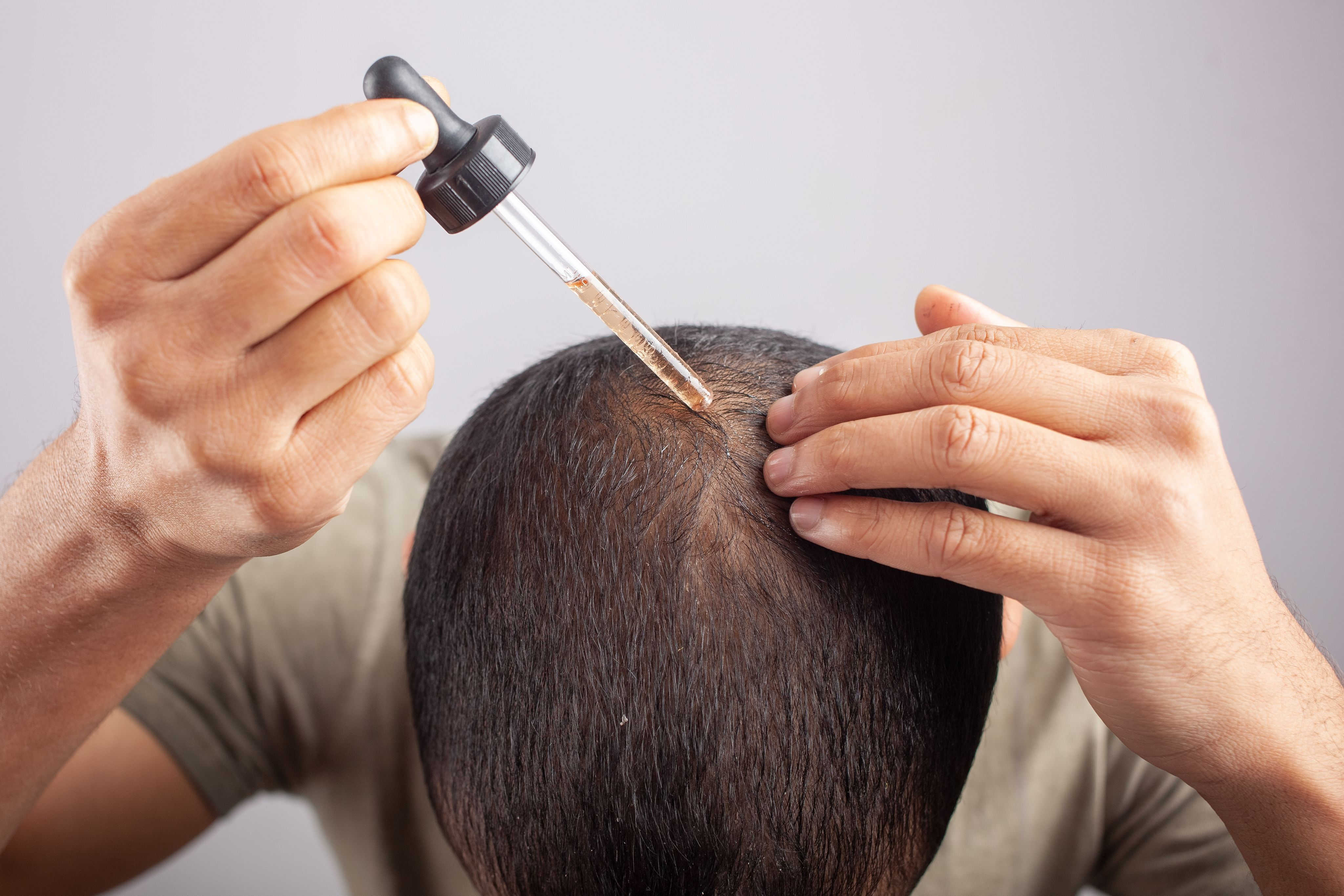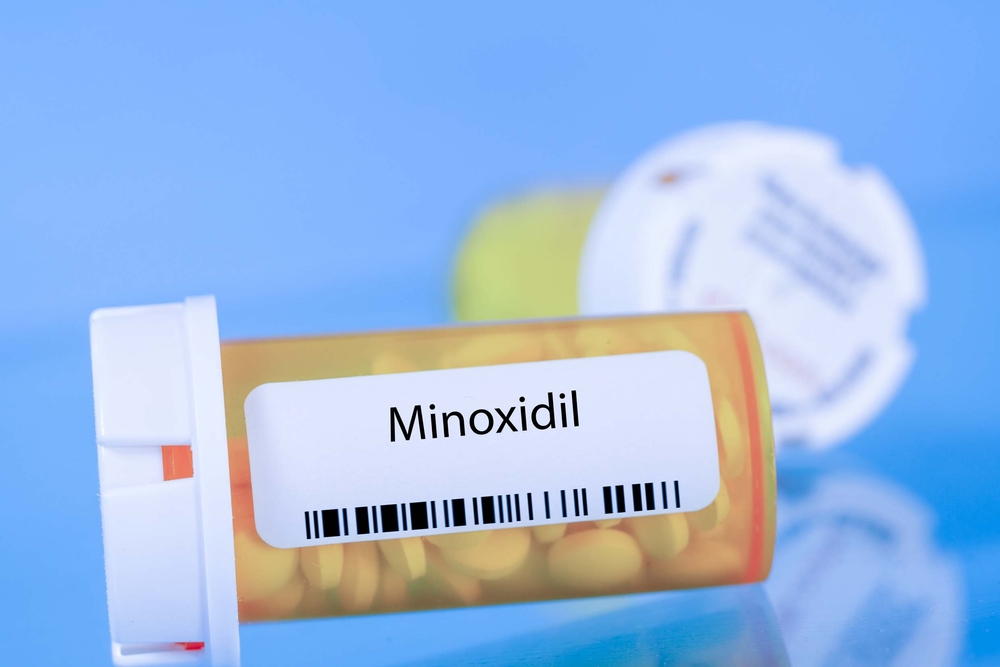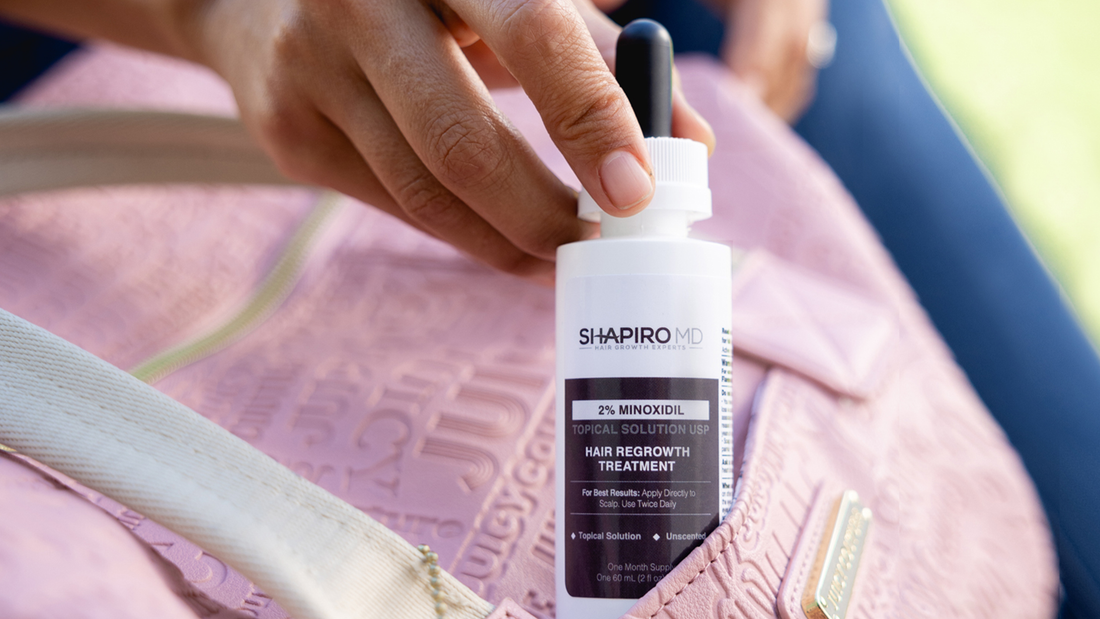If you’ve poked around the world of hair loss treatments, you know that minoxidil (originally branded Rogaine® but now available as a generic) is one of your best options.
It’s been around for decades, it’s FDA approved, it’s easy to use as a topical, it’s available over-the-counter and online (no prescription required), and it works well for most people who try it!
Minoxidil can slow hair loss, stop hair loss, and even help to regrow hair. But minoxidil is only available from stores in topical formulas. That’s despite oral minoxidil (in pill forms) having shown an ability to also help regrow hair when taken once daily.
Oral minoxidil, however, isn’t easy to get.
That's because oral minoxidil is available by prescription only to treat certain types of hypertension (high blood pressure), though it’s also been tested and used successfully in hair loss. Numerous studies have proven this out, but it’s never been approved by the U.S. FDA.
So what’s the story? Can you get oral minoxidil? Does oral minoxidil work? Here’s everything to know.
Summary
- Minoxidil is approved by the FDA as a topical treatment for hair loss in both men and women. It has also been used orally for hair loss treatment with success, but it is not approved by the FDA in this form.
- Oral minoxidil is only available “off label” with a doctor’s prescription and at very low doses. To get oral minoxidil, you’ll need the help of an experienced dermatologist who is comfortable prescribing oral minoxidil for hair loss. Most general practitioners will not be familiar with this approach to hair loss treatment.
- People on blood pressure medication will need to take extra precautions if using oral minoxidil, and doctors may prescribe additional medication to prevent severe side effects.
- Minoxidil alternatives include finasteride, vitamin supplements, hair transplants, and hair growth products like shampoos and serums with proven active ingredients.

What Is Minoxidil?
Minoxidil is a treatment that can be used topically or orally to treat hair loss in both men and women.
Only topical minoxidil in strengths of 2% and 5% have been approved by the FDA as hair growth treatments for androgenic alopecia (standard male and female pattern baldness), but oral minoxidil has not yet been approved as a hair loss treatment.
Oral minoxidil is an antihypertensive, which is a class of blood pressure medications. It has only been FDA-approved to treat high blood pressure; however, doctors have started prescribing low-dose oral minoxidil for hair loss.
When it’s used for treating hair loss, lower doses of oral minoxidil work well, while higher doses are reserved for treating blood pressure.
Oral Minoxidil vs. Topical Minoxidil: What’s the Difference?
One clinical trial that tested the effects of 1 mg oral minoxidil and a 5% topical minoxidil solution for female pattern hair loss, found that hair growth results were more or less the same.
There are, however, clear differences between oral minoxidil treatment and topical minoxidil.
| Oral minoxidil* | Topical minoxidil |
| Prescription medication | Over-the-counter medication |
| Need to stay on oral minoxidil to maintain hair growth. | Need to keep applying the topical solution to maintain hair growth. |
| Not FDA-approved for hair loss—hair loss treatment is an off-label use. | Liquid and foam minoxidil are FDA-approved for hair loss. |
| Not to be used during pregnancy. | Not to be used during pregnancy. |
| Unwanted hair growth may occur—such as hair on the face, back, arms, and legs. This is known as hypertrichosis. | Hair growth occurs only in areas where the minoxidil is applied. |
| Dosage is typically the same for both men and women. | Men can use higher doses, while women use lower doses. |
| It can take between 6 and 12 months before you start seeing results. | It can take between 2 and 4 months before you start seeing results. |
| No risk of contact dermatitis. | May lead to contact dermatitis. |
| No extra hair washes are required with oral minoxidil. | Topical minoxidil can make hair appear greasy, so you may need to wash it more frequently. |
| Dosages are consistent because the same tablet is taken each day. | Dosages may be inconsistent as it’s difficult to control the precise amount of minoxidil that’s used on the scalp.
For example, when applied with a dropper, some parts of the scalp may receive higher concentrations of minoxidil than others. |
| It may affect your blood pressure.
Those on existing blood pressure medications should speak to their doctor and consistently monitor blood pressure readings. |
Should not affect blood pressure or generate other systemic side effects. |
How Effective Is Oral Minoxidil for Hair Loss?
Several studies have demonstrated the effectiveness of oral minoxidil for hair loss.
The effects of the drug were studied in patients with mainly androgenic alopecia, but other hair loss conditions—such as LAS, alopecia areata, telogen effluvium, and chemotherapy-induced alopecia—have also been evaluated.
According to the research, oral minoxidil is a well-tolerated option for healthy patients who have not experienced their desired hair growth results with topical treatments.
Remember, the effects of both topical and oral minoxidil will only last for as long as you use it. To maintain your hair growth, you’ll need to stay on the treatment.
What Are the Benefits of Oral Minoxidil?
Although oral and topical minoxidil produces similar hair regrowth results—and one does not necessarily work better than the other—there may be additional benefits to using oral minoxidil.
Some benefits of low-dose oral minoxidil include:
- Controlled dosage: When you’re taking oral minoxidil, you can control the amount of medication you use and see more consistent results than when you’re using topical minoxidil.
- Easy to use: With oral minoxidil, you simply swallow a pill, while applying topical minoxidil is a little more time-consuming.
- No extra hair care steps: Topical minoxidil may make your hair greasy and you’ll need to wash it more often. Oral minoxidil does not have this side effect.
- No risk of contact dermatitis.
- No risk of a rash, burning, or tingling occurring on the scalp.
Why Doesn't Topical Minoxidil Work for Everyone?
When applied to the scalp, topical minoxidil requires the enzyme SULT1A1 (sulfotransferase) to turn it into its active form. Some people do not have this enzyme in their scalp and won't benefit from topical preparations of minoxidil.
This enzyme is, however, present in the liver. So oral minoxidil tablets may work even if topical versions of the drug don't.
What Types of Hair Loss Can Oral Minoxidil Treat?
Oral minoxidil is not approved by the FDA for the treatment of hair loss, but clinical trials have shown good results when it is taken daily.
Those with the following hair loss conditions might consider oral minoxidil:
Androgenic alopecia
Also known as male or female pattern hair loss, androgenic alopecia is commonly caused by genetics.
In other words, if hair loss runs in your family, there’s a good chance that you’ll develop the condition at some point.
Studies have shown that oral minoxidil can safely and effectively treat this type of hair loss.
Telogen effluvium
Telogen effluvium is sudden hair loss that occurs in response to a stressful event. While it is normal to shed some hair every day, sudden, patchy hair loss should be cause for concern.
Because this type of hair loss is temporary, it can be treated with minoxidil.
A recent study that examined the effects of oral minoxidil on women with chronic telogen effluvium (CTE), found that when taken once a day, oral minoxidil reduces hair shedding.
Traction alopecia
Hair loss that occurs due to constantly pulling the hair is known as traction alopecia. Tight or restrictive hairstyles can cause this type of hair loss.
People who style their hair in tight buns, braids, or ponytails are prone to developing traction alopecia.
The consistent use of chemical treatments and heat can also weaken the hair, making it easier to break or fall out.
This kind of hair loss is reversible if hair care practices are changed in the early stages of the condition.
One small study examined the effects of oral minoxidil on a 31-year-old woman with decreased hair density due to wearing tight hairstyles and using chemical relaxers.
Topical minoxidil did not work for her, but oral minoxidil showed promising hair growth.
Loose anagen syndrome (LAS)
Sometimes called loose anagen hair syndrome, loose anagen syndrome is a condition characterized by hairs that fall out during the anagen phase of the hair growth cycle.
The anagen phase refers to the active phase of the hair growth cycle. Any hairs on your scalp that are still growing are in this phase.
Loose anagen hair syndrome commonly occurs in children, but it may also affect adults.
Hair loss from LAS is usually temporary, and minoxidil can help speed up regrowth in adult patients. Minoxidil should not be used by patients younger than 18.
Hair loss related to cancer treatment
Chemotherapy treatment often causes hair on the scalp and the rest of the body to fall out.
One of oral minoxidil’s side effects is hair growth all over the body—but this may be a benefit in the case of cancer patients.
There is some evidence to suggest that those struggling with chemotherapy-induced alopecia may benefit from oral minoxidil with no unexpected side effects.

What Are the Side Effects of Oral Minoxidil?
The higher your dose of oral minoxidil, the greater your chances of developing adverse effects. This is one of the reasons the treatment is often started at a low dose, and a reason that many dotors are not familiar with using oral minoxidil.
If you are already on blood pressure medication, be sure to tell your doctor beefore trying oral minoxidil for hair loss. Extra steps may need to be taken—such as monitoring and recording your blood pressure readings regularly.
Your doctor may also prescribe additional medication to decrease the risk of side effects. If you have any concerns about starting treatment, discuss them with your doctor beforehand.
Contact your doctor immediately if you experience any of the following:
- Chest pain or increased heart rate.
- Sudden weight gain.
- Breathing difficulties—especially when lying down.
- Dizziness.
- Pain in the arms or shoulders.
Other side effects include:
- Hypertrichosis—sometimes called werewolf syndrome, this rare condition results in excessive hair growth anywhere on the body.
- Fluid retention.
- Hives.
- Nausea or vomiting.
- Headaches.
- Nightmares or trouble sleeping.
- Skin rashes.
- Breast tenderness.
Is Oral Minoxidil Harmful?
Studies on the safety of oral minoxidil have been conducted and research shows that it is safe for most people to use. Side effects are rare—only 1.7% of all study participants discontinued treatment because of adverse effects.
How Do I Take Oral Minoxidil?
Oral minoxidil is a prescription medication in the U.S., so you’ll need to visit a doctor for professional medical advice before you can start treatment.
Additionally, oral minoxidil is available off-label only (it’s not FDA approved for hair loss). Many doctors may not be comfortable with this, and getting oral minoxidil may require visiting a dermatologist or other doctor with extensive experience treating hair loss.
Doses of oral minoxidil
The recommended dosage of oral minoxidil can vary depending on your gender and other health conditions.
Lower doses are typically prescribed for women, while higher doses are reserved for men.
The reason why women are often prescribed lower doses of minoxidil than men is due to the side effect of hair growth on areas of the body other than the scalp.
The American Academy of Dermatology (AAD) recommends oral minoxidil as a treatment for all hair loss conditions as it increases hair volume and thickness, and tolerance is generally good.
Oral minoxidil for hair loss is typically available in doses of 2.5 mg, 5 mg, and 10 mg. Your doctor may start you off on the lowest dose and gradually increase it as your body adjusts.
Should I Make Any Lifestyle Changes When I Start Oral Minoxidil?
Because oral minoxidil can lower blood pressure, it can be useful to cut down on foods and beverages that have the same effect.
For example, limiting alcohol intake may help as alcohol reduces blood pressure.
Cutting down on your caffeine intake is also a good idea as too much caffeine can cause heart palpitations.
If you’re already taking blood pressure medication, your doctor will provide you with advice on how to proceed. For example, you may have to take blood pressure readings more often or use additional medication to reduce the risk of certain oral minoxidil side effects.
Should I combine minoxidil with finasteride?
Research has shown that topical minoxidil combined with finasteride (a drug used to treat male pattern baldness) can yield great results and help improve hair density.
Finasteride has been FDA-approved for treating male pattern hair loss, but it should not be used by women as it’s been classified as a pregnancy risk.
A cocktail of minoxidil and finasteride can work wonders to stimulate hair growth in men. This combination works so well that Shapiro MD offers these two powerhouse products in one hair regrowth kit.
Can I Switch from Topical to Oral Minoxidil?
People who do not have success with minoxidil in its topical form can speak to their doctor about switching to oral minoxidil.
However, every person’s situation is different and it’s best to seek professional medical advice when stopping medication or switching to a different type of hair loss treatment.
If, for example, topical minoxidil has been working for you but you’d like to switch to oral minoxidil because it’s more convenient, you’ll need to consult your doctor. A physician will be able to provide the best advice.
What Happens If I Stop Using Oral Minoxidil?
You need to continue using oral minoxidil to maintain your hair growth.
Any results you've seen while using the treatment will disappear once you stop the medication.
It is also not advisable to suddenly stop taking medication prescribed by a doctor. Abrupt discontinuation of medication can lead to severe side effects.
Always get in touch with your doctor if the medication they've prescribed is not working or you need to stop using it for any reason.
When Should I Not Use Oral Minoxidil?
In the U.S., oral minoxidil—and topical minoxidil—may not be used by people younger than 18.
If you experience any of the side effects mentioned in this article, you should contact your doctor and speak to them about alternative hair loss treatments.
What are some alternatives to minoxidil?
Minoxidil is an effective hair loss treatment, but it may not be the right choice for you. Several effective, alternative hair loss solutions are available.
Finasteride
Finasteride is another FDA-approved hair growth treatment—but for men only. Your doctor will be able to prescribe this oral medication.
You can buy finasteride online via Shapiro MD’s website, if approved.
Hair transplants
Hair transplants have become a popular—but costly—solution to hair loss.
A hair transplant is a safe procedure that very rarely has complications. It can take six months to a year before you see fully integrated results.
Making lifestyle changes
A balanced diet, reducing stress, and ensuring that you get enough sleep and exercise may help to prevent or reverse some premature hair loss.
Addressing vitamin and mineral deficiencies
Studies have shown that people with hair loss is sometimes associated with vitamin and mineral deficiencies.
Correcting these deficiencies by eating the right foods or taking vitamin supplements may help you reduce hair thinning.
Addressing underlying health conditions
Thyroid disorders, anemia, pregnancy, anxiety, and scalp infections are some conditions that can cause hair loss.
Regular medical checkups will help you diagnose and treat any medical conditions that may be causing your hair loss.
Using the right hair care products and practices
Certain hair care practices—such as washing your hair too often or styling it in certain ways—can contribute to hair loss. Using harsh hair care products can also cause hair thinning and brittleness.
Shapiro MD formulates a wide range of premium shampoos, serums, and hair growth kits to help you grow healthy hair and slow down premature hair loss.
Where Can I Learn More about Minoxidil for Hair Loss?
Are you struggling with hair loss? Do you think minoxidil might be the solution? Shapiro MD can get you on the right track.
The earlier you get started with quality hair loss formulas, the better your chances of success.
Take our quick online hair quiz today and learn which of our solutions might work best work for you.
References
https://www.statista.com/topics/4552/hair-care-product-market-in-the-us/#topicHeader__wrapper
https://pubmed.ncbi.nlm.nih.gov/31403367/
https://www.accessdata.fda.gov/drugsatfda_docs/label/2015/018154s026lbl.pdf
https://pubmed.ncbi.nlm.nih.gov/32622136/
https://www.jaad.org/article/S0190-9622(19)32666-0/fulltext
https://www.ncbi.nlm.nih.gov/pmc/articles/PMC6691938/
https://www.ncbi.nlm.nih.gov/books/NBK482378/
https://pubmed.ncbi.nlm.nih.gov/32516434/
https://www.ncbi.nlm.nih.gov/pmc/articles/PMC5676194/
https://www.ncbi.nlm.nih.gov/pmc/articles/PMC9039860/
https://ascopubs.org/doi/abs/10.1200/JCO.2022.40.16_suppl.12022
https://pubmed.ncbi.nlm.nih.gov/32622136/
https://pubmed.ncbi.nlm.nih.gov/33639244/
https://www.aad.org/dw/dw-insights-and-inquiries/archive/2022/low-dose-oral-minoxidil-alopecia
https://www.ncbi.nlm.nih.gov/books/NBK513329/
https://www.accessdata.fda.gov/drugsatfda_docs/label/2011/020788Orig1s022lbl.pdf
https://www.gq.com/story/hair-transplant




